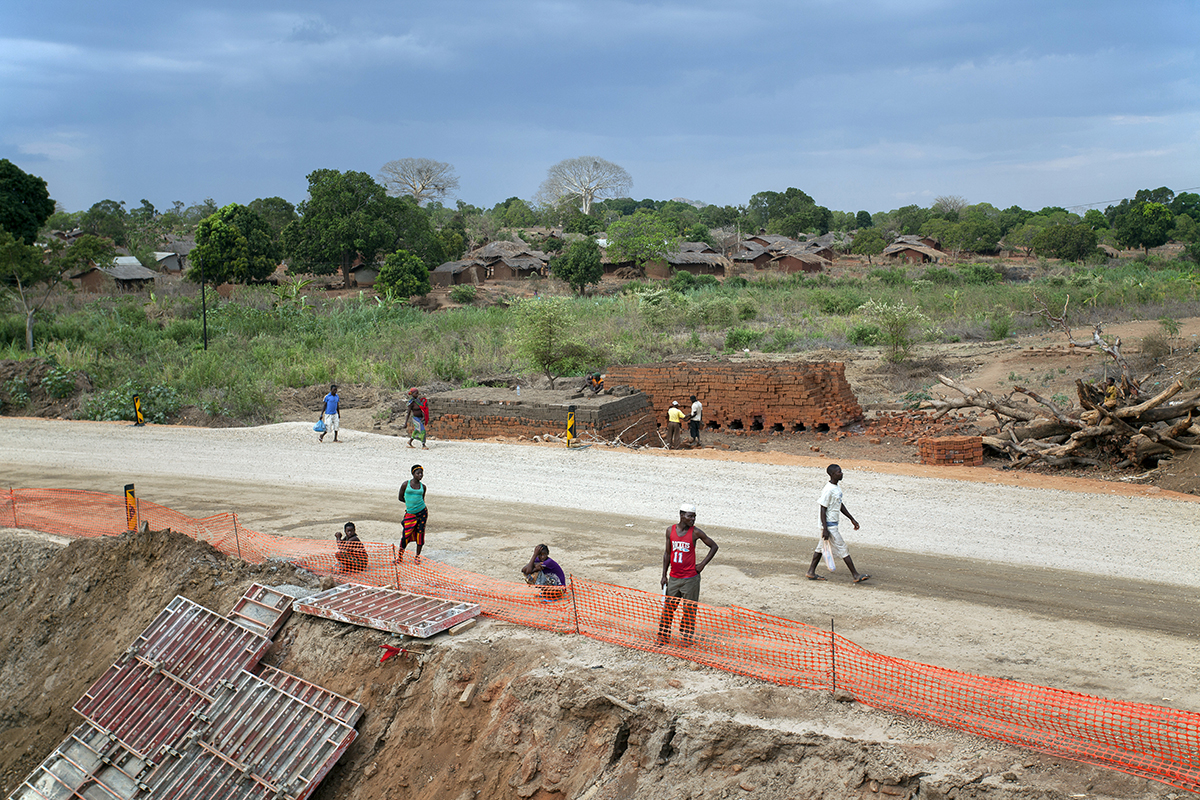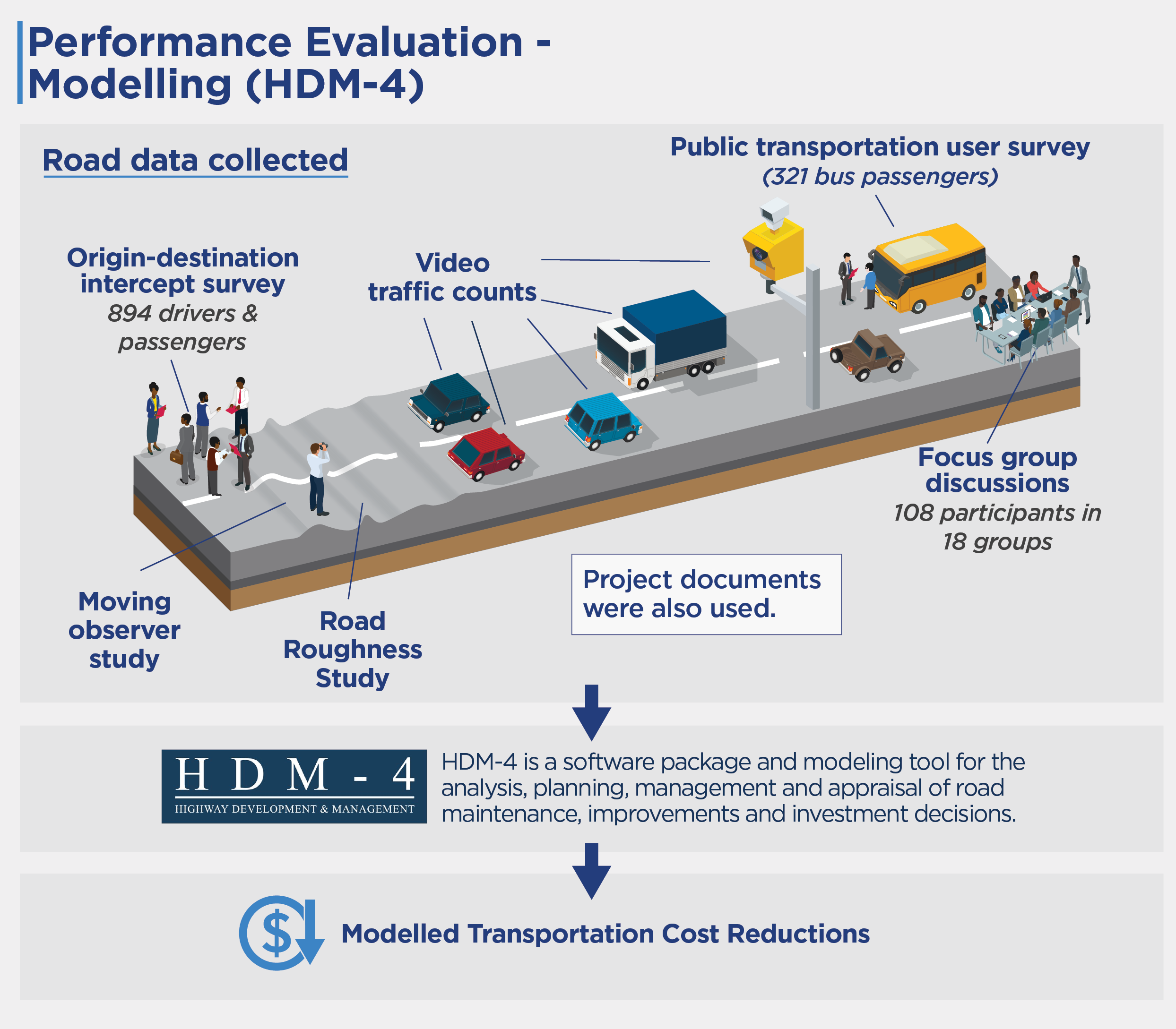Program Overview
MCC’s $447.9 million Mozambique Compact (2008-2013) supported the $136.8 million Roads Rehabilitation Project which rehabilitated two primary national road segments: Namialo-Rio Lurio Road (149.7 km) and Nampula-Rio Ligonha Road (103 km). The rehabilitation activities included lane configuration rehabilitation; strengthening the pavement structure; widening of bridges; design and construction of drainage structures; signage post installation; and safety improvements. The project aimed to improve road quality and reduce transportation costs, thereby improving access to markets, resources, and services. The project also aimed to expand connectivity across the northern region, including towards the south.
Key Findings
Project Implementation
- The project originally aimed to rehabilitate 491 km of National Route 1.
- Due to higher-than-expected construction costs found during feasibility studies, the activity was rescoped to two segments totaling 253 km of improved roads.
Transport Costs and Vehicle Operating Cost Savings
- The project is estimated to have reduced vehicle operating costs by $12.5 million on the Nampula - Rio Ligonha Road and $8.4 million on the Namialo - Rio Lurio Road by the year 2023.
- For the Nampula segment, this reduction is greater than what was anticipated at the time of the Investment Decision, while for the Namialo segment, the reduction was slightly less.
Maintenance Practices
- The National Road Administration exhibited good-to-fair maintenance practices even when road sector financing was limited and/or diverted to emergency activities.
- It is assumed that the maintenance level applied will continue for the foreseeable future.
Time Savings for Travelers
- A Travel Time Study revealed time savings of 0.9 hours on the Nampula - Rio Ligonha Road and 1.4 hours on the Namialo - Rio Lurio Road by passenger cars.
- Truck and bus drivers reported experiencing significant time savings during their journeys.
Evaluation Questions
This final performance evaluation was designed to answer the following questions:
- 1
Was the project implemented according to plan? - 2
Did the project reduce transportation costs? - 3
What are the relevant road authority’s current maintenance practices, and what is the likelihood that MCC’s investment will remain adequately maintained? - 4
How has travel time changed as a result of the project?
Detailed Findings
Project Implementation

Road undergoing rehabilitation
It was originally planned that the Roads Rehabilitation Project would rehabilitate 491 km of National Route 1, which forms the backbone of the country’s transportation network, including Rio Lurio – Metoro in Cabo Delgado (74 km); Namialo – Rio Lurio (148 km), and Nampula – Rio Ligonha (102 km) in Nampula; and Nicoadala – Chimuara (167 km) in Zambézia. However, due to higher-than-expected costs identified during the preparation of full feasibility studies and detailed engineering designs, as well as additional technical and regulatory information gathered during the design phase, MCC and the Government of Mozambique agreed to re-scope the activity to two segments in Nampula Province: Namialo – Rio Lurio (150 km actual) and Nampula – Rio Ligonha (103 km actual), totaling 253 km of improved roads.
At the conclusion of the Compact, approximately 90 percent of the 150-km road segment and 70 percent of the 103-km segment had been completed. As a result, the Government of Mozambique committed an additional $7 million to finish the works and cover the associated project management costs. These works were completed in December 2014.
Transport Costs and Vehicle Operating Cost Savings
The project is estimated to have reduced vehicle operating costs by $12.5 million on the Nampula - Rio Ligonha Road and $8.4 million on the Namialo - Rio Lurio Road by the year 2023. For the Nampula segment, this reduction is greater than what was anticipated in the Cost Benefit Analysis for the same year at the time of the Investment Decision ($6.3 million, or $8.6 million in 2023 price valuation), while for the Namialo segment, the reduction was slightly less than what was expected ($8.1 million, or $11.2 million in 2023 price valuation).
Maintenance Practices

Ten years after works completion, the overall condition of the roads is considered fair to good. The current International Roughness Index (IRI) level is 3.5 m/km (with lower scores being better). The evaluation projects adequate maintenance for the 15-year investment life. There is a low occurrence of potholes (perhaps one every 10 km), patching and raveling, and no cracking observed. This indicates adequate routine maintenance despite challenging external factors (e.g. hidden debt crisis, insurgency in the north, tropical cyclones). At the time of the evaluation, periodic maintenance had not yet been required.
Time Savings for Travelers
A Travel Time Study indicated travel time savings for passenger cars of 0.9 hours and 1.4 hours on the Nampula–Rio Lighona road and the Namialo-Rio Lurio Roads respectively. Focus Group Discussions support the finding that there has been significant time savings. Among all effects of the rehabilitated road, shorter travel time was cited by the largest share of public transport respondents (54.9 percent).
Bus passengers surveyed reported that they saved a day or more traveling along the rehabilitated road. This is due to travelers being able to complete a trip in one day as opposed to having to spend the night en route or at their destination.
Economic Rate of Return
MCC generally considers a 10% economic rate of return (ERR) as the threshold to proceed with investment.
- 8.8%
Nampula - Rio Ligonha - 8.4%
Namialo – Rio Lúrio
Original ERR (2009)
- 0.65%
Nampula - Rio Ligonha - -0.19%
Namialo – Rio Lúrio
Re-scoped ERR (2012)
- 12.6%
Nampula - Rio Ligonha - 3.9%
Namialo – Rio Lúrio
Evaluation-Based ERR
The original ERR was based on an early feasibility study. After this, more detailed studies revealed that costs were higher than originally anticipated, causing the project to be de-scoped from 4 to 2 road segments, and a reduction in ERR to 0.65% and -0.19% for the remaining Nampula and Namialo segments respectively. In addition to the increase in cost, the reduction was also driven by an improved IRI value in the “without project” scenario and a change in maintenance assumption to “poor” in the “with project” scenario.
The evaluation ERRs are much higher as a result of better-than-expected pavement performance, good maintenance observed, higher traffic growth, and a 20% cost reduction compared to the re-scoping analysis cost in the case of the Nampula-Rio Lighonha Road.
MCC Learning
Routine maintenance, if performed frequently enough, can defer periodic maintenance.
Detailed studies (feasibility, RAPS, ESIAs, engineering designs) should be done before the Compact enters into force in order to get an accurate understanding of costs as early as possible.
Evaluation Methods

The overall methodology was an ex-post performance evaluation using HDM-4 modeling.
The exposure period was from 89-101 months (from September 2014 until the respective evaluation data collections were conducted). This translates to between roughly 7.5 and 8.5 years.
Data was collected from road users through an Origin-Destination survey (n = 894), a Public Transportation User survey (n = 321), focus group discussions (n = 108 participants in 18 FGDs), and from key stakeholders through key informant interviews (n = 18), as well as from project documents. A video traffic count was conducted, and a moving observer study was used to assess road usage patterns. A road roughness study, travel time study, and a road conditions survey were conducted.
2024-002-3000


